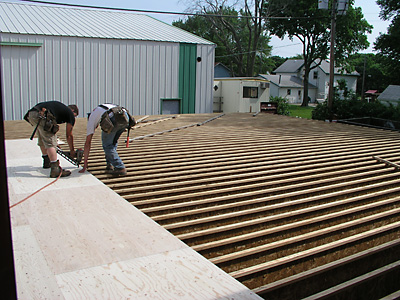Marquette finally signing in. Sorry for the delay; my run (well...my walk/jog/rolling-over-dead-because-I'm-out-of-shape) took longer than I thought. I'm alive though (I find that a good thing) and here's this morning's Pinstrosity.
A submitter sent us an a pin they followed to try and stop the creaking in their hard wood floors. Here's how it went down.
The Original Pin
We actually don't have a picture for this one as there is not a photo for this tip on the original site. Just picture a hard wood floor in your imagination. Here's what the original site said though:
"To silence your squeaky hardwood floors sprinkle some baby powder on the squeaky area and sweep it into the cracks. Then wipe the floor. The baby powder between the boards will act as a lubricant and will stop the annoying noise."
The Pinstrosity
We were told by our submitter that the "floor still creaks and it made a mess! I tracked powder all through the house and it was hard to clean up. Would NOT recommend! But I now know that I don't have ghosts because there were no additional footprints in the morning =)"
Growing up as the daughter of an excellent General Contractor and spending quite a bit of time with him in the homes he was building, this idea immediately seemed a little too narrow to work every time. While this trick may work for some creaks there are just too many places for and causes of creaky floors for the baby powder trick to work every time with ever floor. Now I'm not saying this won't ever work, but it isn't not going to work with every case.
So we'll take a look at what can cause creaky squeaky floors but first we probably need a quick anatomy of a wood frame floor lesson.
 |
| Photo source: http://www.february-11.com/2a_floors_o.html (I erased a few terms because there was more than we needed for this lesson, for all the original labels please follow the link). |
The skeleton of the floor is made up basically of the joists (I know that's a little oversimplified, but for our purposes it works just fine). The joists are the parallel boards you see in the pictures above and below. After the joists and placed, the sub-flooring is laid (which is precisely what the men in the picture below are doing).
 |
| photo source: http://www.dobsonorgan.com/html/shop/construction/construction.html |
After the subflooring a layer of building paper or matting is laid, and then the finish floor, or the top layer. With concrete bases there are no joists, rather a matting layer and then the finish floor.
So now that we've got that covered, let's look at what can cause the pesky creaks.
Familyhandman.com says that "floor squeaks are caused by wood rubbing against a nail, other wood, or even ductwork and piping." Naturalhandyman.com expands on that and gets a little more technical, saying that "squeaks are caused by movement in wood seams between sheets of subflooring, friction noise in tongue and groove or shiplap flooring [the finish floor], and fingernails-on-blackboard rubbing against loosened nails."
Since the root of the problem can lie anywhere in the structure of the floor, stopping the creak may take more than just baby powder in the cracks. When does baby powder work best? When the creaks are located in the finish flooring (which creaks are usually caused by the finish flooring pieces rubbing against each other). If the creak lies further in the floor (in the sub-flooring or joists), baby powder probably just won't work it's way far enough in to do the job.
If the creak does not lie in the finish flooring you will have more work to do than just sprinkling powder on the floor and sweeping it in the cracks. So what to do then? You have to reinforce the structure. How? I'm actually going to leave this one to the experts. There are two great references for you (well, there are tons of great references, but these are the two I found most helpful in preparing for this post). Check out The Family Handy Man and The Natural Handyman. Both have great tips and instructions and steps you can take to try and stop the creaks in your floor.







This Old House actually has an EXCELLENT videos and How-tos for fixing squeaky floors for carpeted areas, hardwood, etc. I used this link to fix our upstairs floors: http://www.thisoldhouse.com/toh/video/0,,20045284,00.html
ReplyDeleteI was nervous about finding the joists so I hired a carpenter on Craigslist and he did it for me.
This site is my new FAVORITE. The ghost detection is probably the best use of the baby powder!
ReplyDeleteTo be fair, the instructions I read for using baby powder on squeaks did say to sweep it into the cracks and then WIPE UP THE REST. I tried it, and while it did help the tiniest bit, there are still too many squeaks in the subfloor level to really notice it. So, not much help - although my hallway does smell really fresh now!
ReplyDeleteI love this website so much. SO MUCH. Kudos on a job well done!
ReplyDeleteI wouldn't try this project due to the fact that even after sweeping up baby powder, it can still leave the floor incredibly slippery.
ReplyDeleteIf anyone is considering building a house, or if you ever replace the carpet or hardwood floors, exposing the subfloor, then take the time to actually screw the subfloor to the joists, not nail. We flip houses. Typically we will add an adhesive to the joists and then add the plywood (made in USA, the imported stuff can contain harmful chemicals like formaldehyde that can leech into your carpet). Use a chalk snapline to mark where to put the screws and borrow one of your teenagers if you have one to do the job. It's pretty simple with a cordless drill or a stand up screw gun.
ReplyDelete